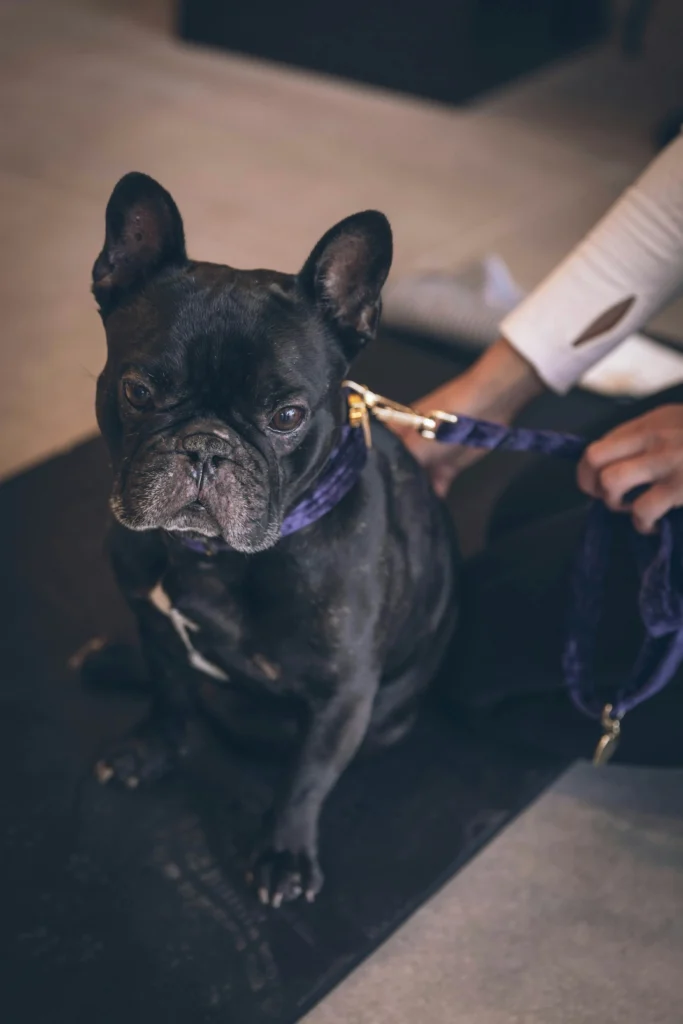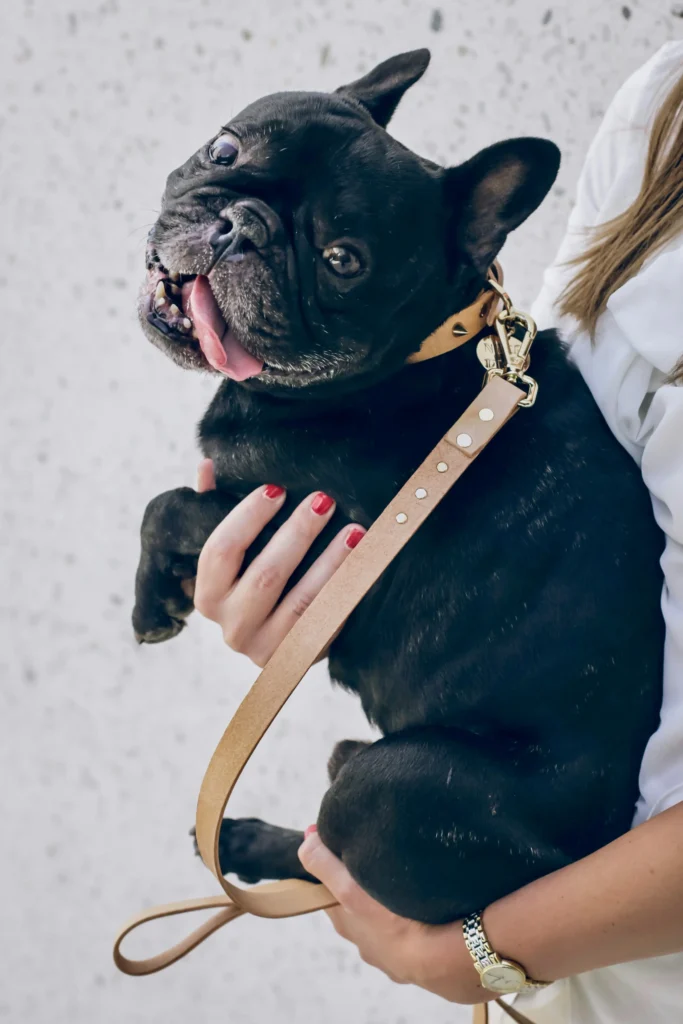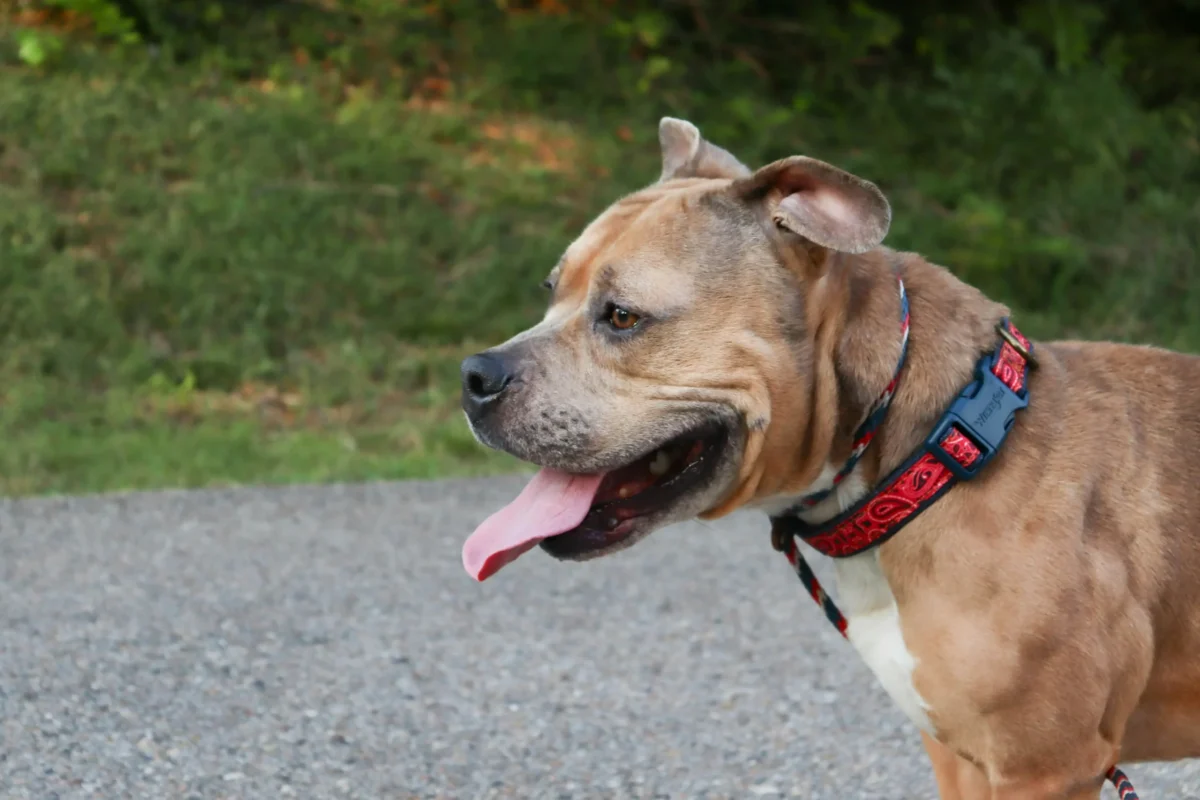Last updated: October 19, 2025
Quick Answer
Measure your Frenchie’s neck where a collar naturally sits. Adjust the collar so you can slide two fingers flat under the strap. Most Frenchies do well with a flat, slightly wider collar with smooth edges and a sturdy buckle. Many owners use a harness for the leash and keep the collar for ID tags.
Key Takeaways
- Fit comes first. Measure the neck and use the two-finger test for comfort.
- Choose a sensible width. A slightly wider collar (about ¾–1¼ inch) spreads pressure on a short neck.
- Hardware matters. Look for a strong buckle, a welded D-ring, and smooth edges.
- Split the jobs. Many people leash to a harness and keep a collar on for ID and visibility.
Why Frenchie Shape Changes Collar Fit
French Bulldogs are small but muscular. They have a broad, deep chest and a short neck. Because of this shape, collar fit and finish matter more than a size label. A narrow, rough strap can dig in. An extra-wide, stiff strap can rub.
Breed standards describe this shape clearly. They are neutral references and not sales pages:
- AKC standard (PDF): compact and muscular; broad, deep, full chest
https://images.akc.org/pdf/breeds/standards/FrenchBulldog.pdf - The Kennel Club (UK) standard: cobby, muscular; broad chest
https://www.thekennelclub.org.uk/breed-standards/utility/french-bulldog/ - FCI standard No. 101: small molossian; deep, broad chest
https://www.fci.be/Nomenclature/Standards/101g09-en.pdf
These phrases explain why a collar should be adjusted carefully and why a bit more width and smooth finishing often feel better on a Frenchie.
Measure, Then Match (Simple Method)
What you need: a soft tape measure.
- Measure the neck where the collar will sit. Do not measure high on the skull or low on the shoulders.
- Use the two-finger test. When the collar is on, you should slide two fingers flat under the strap. It should feel snug, but not tight.
- Fine-tune. If the collar rides up toward the skull, tilts the D-ring, or spins too easily, adjust one hole or consider a different width.
- Re-check during the year. Weight, coat thickness, and strap stretch change fit. Take a fresh measurement now and then.
For health concerns, consult your veterinarian.

Width and Materials (What to Expect)
Width guide: Many Frenchies are comfortable with ¾–1¼ inch collars.
- Too narrow can press into a short neck.
- Too wide can feel bulky and rub at the edges.
Aim for a middle ground with clean, smooth edges.
Material types (plain English):
- Nylon: Light, affordable, and quick to dry. Check edge binding and stitching around the buckle and D-ring.
- Biothane/coated webbing: Wipe-clean and weather-ready. It keeps a smooth feel and holds its shape.
- Leather: Comfortable and long-lasting when finished well. Beveled or rolled edges are kinder to the neck.
- Reflective trim: Helpful at night. Make sure it’s applied cleanly so it does not scratch.
Edge finishing matters. Rolled or bound edges, good rivets, and a smooth buckle tongue reduce rubbing and hot spots.
Collar Types (Neutral Overview)
- Flat buckle collar: The everyday classic for ID tags. Choose a solid buckle and a welded D-ring that sits flat.
- Quick-release collar: Easy on and off with a side-squeeze buckle. Pick a robust clasp made for collar loads.
- Limited-slip / martingale: Designed to reduce slip-offs on some head shapes. Fit these carefully and use as directed.
- Reflective/visibility collars: Useful for low-light walks. Make sure reflective areas don’t create rough edges.
Most families find a flat buckle collar ideal for ID. If you prefer to leash to a harness, keep a simple collar on for tags.
Helpful neutral primers from AKC:
- Choosing the Right Dog Collar: https://www.akc.org/expert-advice/training/choosing-the-right-dog-collar/
- Choosing the Right Dog Harness: https://www.akc.org/expert-advice/training/choosing-the-right-dog-harness/
Photo ID Tips (Checklist)
Use this quick list when checking fit in photos or a mirror:
- ☐ Good light. You can see strap edges and the buckle clearly.
- ☐ Front, side, ¾ views. These angles show tilt, riding up, or gaping.
- ☐ Two-finger space. Two fingers slide flat under the strap.
- ☐ No riding up. The collar sits at the base of the neck, not near the skull.
- ☐ No marks. Edges aren’t parting the coat or leaving impressions after removal.
- ☐ Tag check. Tag text is readable; the D-ring lies flat, not twisted.
Standards Snapshot (Context Only)
- AKC standard (PDF): https://images.akc.org/pdf/breeds/standards/FrenchBulldog.pdf
- KC (UK) standard: https://www.thekennelclub.org.uk/breed-standards/utility/french-bulldog/
- FCI standard No. 101: https://www.fci.be/Nomenclature/Standards/101g09-en.pdf

Collar vs Harness (A Practical Split)
There isn’t one “right” setup for everyone. A common and simple approach is collar for ID and harness for the leash. A harness spreads forces over a larger area. If you use both, make sure the collar and harness do not rub each other and that the leash ring on your harness suits your walking style.
For ID and preparedness basics, see the ASPCA’s general pet care page:
https://www.aspca.org/pet-care
Everyday Care (Short and Simple)
- Wipe nylon or biothane after wet or muddy walks.
- Treat leather lightly if it looks dry. Avoid heavy oiling.
- Rinse salt, sand, and grit to protect stitching and hardware.
- Retire collars with cracked straps, loose stitches, or bent hardware.
For health concerns, consult your veterinarian.
FAQs
How tight should a French Bulldog’s collar be?
It should feel snug but not tight. You should slide two fingers flat under the strap. The collar should not ride up toward the skull, twist the D-ring, or leave marks.
What collar width works well for most Frenchies?
Many Frenchies are comfortable with ¾–1¼ inch widths. This range spreads pressure on a short neck without feeling bulky. Smooth edges and solid hardware matter as much as the number on the tag.
Which buckle is easiest and secure?
A good metal tongue buckle or a strong side-release buckle both work. Focus on build quality: smooth edges, tight stitching, and a welded D-ring that lies flat.
When would someone choose a harness for walks?
Many owners clip the leash to a harness to spread forces over the body. The collar stays on for ID tags. Choose what helps you handle daily walks comfortably.
How often should I re-check collar fit?
Check several times a year. Neck size and strap stretch can change with seasons and activity. Re-measure where the collar sits and confirm the two-finger space.
Do coat colors change collar size or width?
No. Color has no effect on fit. Measurements and comfort checks guide your choice. For neutral color terminology, see the UC Davis VGL pages.
What are signs it’s time to replace a collar?
Look for fraying, cracked materials, loose stitching, bent hardware, or peeling reflective tape. If the D-ring no longer lies flat or the buckle feels weak, retire it.
Sources Used
- AKC — Choosing the Right Dog Collar: https://www.akc.org/expert-advice/training/choosing-the-right-dog-collar/
- AKC — Choosing the Right Dog Harness: https://www.akc.org/expert-advice/training/choosing-the-right-dog-harness/
- AKC — French Bulldog Standard (PDF): https://images.akc.org/pdf/breeds/standards/FrenchBulldog.pdf
- The Kennel Club (UK) — French Bulldog Breed Standard: https://www.thekennelclub.org.uk/breed-standards/utility/french-bulldog/
- FCI — Standard No. 101 (French Bulldog): https://www.fci.be/Nomenclature/Standards/101g09-en.pdf
- FBDCA — Breed Club: https://frenchbulldogclub.org/
- ASPCA — Pet Care (ID context): https://www.aspca.org/pet-care
- UC Davis VGL — Dog coat color overview: https://vgl.ucdavis.edu/panel/dog-coat-color
- UC Davis VGL — French Bulldog page: https://vgl.ucdavis.edu/panel/french-bulldog



